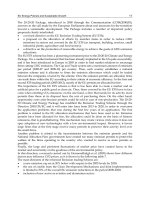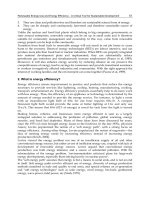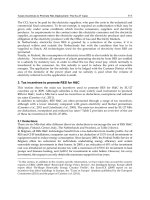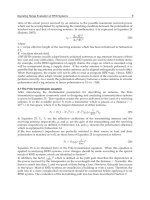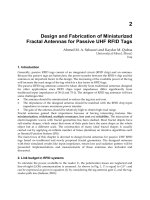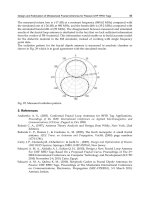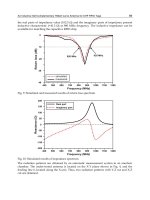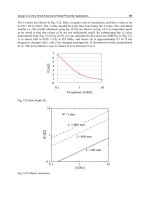Radio Frequency Identification Fundamentals and Applications, Bringing Research to Practice Part 2 potx
Bạn đang xem bản rút gọn của tài liệu. Xem và tải ngay bản đầy đủ của tài liệu tại đây (3.03 MB, 20 trang )
Field Conditions of Interrogation Zone
in Anticollision Radio Frequency Identification Systems with Inductive Coupling
13
Fig. 9. Orientation of tag, which is deviated by
α
and
β
angles from components of magnetic
induction vector: a) deviation in 3D coordinate x-y-z; b) deviation by
α
angle in z-x plane;
c) deviation by
β
angle in
α
-y plane
Next, in second part, by using of the superposition theorem, after deviating tag by
β
angle,
the perpendicular magnetic induction component is given as follows:
yxz
BBB
=
+
α
ββ αβ
(26)
where the values of vector components are given by:
sin( )
yy
BB
=
⋅
β
β
, (27)
cos( )
xz xz
BB
=
⋅
αβ α
β
(28)
It comes from the equations (23)-(28) that the perpendicular magnetic induction component
for passive tag which is deviated by
α
and
β
angles is given by:
cos( ) cos( ) sin( ) cos( ) sin( )
zxy
BB B B
=
⋅⋅+⋅⋅+⋅
αβ
α
βαββ
(29)
Knowing the magnetic induction separately for individual components in directions x, y and
z (B
x
, B
y
, B
z
), the obtained equation (29) permits calculation of the perpendicular magnetic
induction component. The aforementioned necessity of changing tag orientation should be
carried out for assurance of correct tag work in the individual space point P(x,y,z). In this
way, there is possible to calculate the system interrogation zone which is forced by
specification of identified object what results from the necessity of individual tag location on
marked object.
Changes of the interrogation zone for single tag with minimal value of magnetic induction
have been presented as examples in Fig. 10-c, d (calculated results) and Fig. 10-b (measured
results). The black colour represents no communication area between tag and RWD. The
area results from no fulfil condition of minimal magnetic induction (B
min
) for the tag and its
location in relation to perpendicular magnetic induction component.
Above mentioned parallel location of tag and RWD antenna loops causes appearance of
symmetrical interrogation zone and lack of communication area in relation to symmetry axis
Radio Frequency Identification Fundamentals and Applications, Bringing Research to Practice
14
of RWD antenna (Fig. 10-c). The both areas on x-y plane have been presented in upper part
of diagram. Any changes in tag orientation by
α
and
β
angles (Fig. 10-b, d) lead to
modifications in the interrogation zone. For the given tag and its hypothetical orientation,
the communication area has been significantly shifted in direction of tag deviation, while no
communication areas between tag and RWD has appeared in the central part of x-y plane.
The axial symmetry of interrogation zone and no-communication zone disappears in case of
tag deviation by
α
and
β
angles. Such state complicates forecast and unambiguous
description of the tag location, which permits its correct work.
Fig. 10. Perpendicular magnetic induction component for HITAG 1 ISO CARD (B
min
=740 nT)
placed in 0.1m distance from square RWD antenna (a side = 0.3 m):
a) laboratory system, b) measured interrogation zone for deviated tag by
α
,
β
=45
o
,
c) calculated result -
α
,
β
=0
o
; d) calculated result - deviated tag by
α
,
β
=45
o
In case of required passive tag deviation from symmetry axis of antenna loops, the value of
perpendicular magnetic induction component should be always corrected according to the
equation (29), which takes into consideration tag deviation by
α
and β angles. During the
analysis of field conditions, the effect of RWD antenna shape on communication should be
considered additionally. Calculation of the above parameters for given single and
anticollision 3D identification system gives the basis to determine the interrogation zone of
passive RFID systems.
Field Conditions of Interrogation Zone
in Anticollision Radio Frequency Identification Systems with Inductive Coupling
15
4.3 Structural conditions of RWD antenna loop
In the literature on the subject, the magnetic induction relationship for circular conductor
with current is often applied (Cichos, 2002; Microchip, 2004). A situation, when tag antenna
loop is placed on axis of symmetry with RWD antenna loop, is the characteristic case of
radio frequency identification system functioning. The estimation of circle radius on the
basis of the real RWD loop area which is a polygon can lead to errors during the calculation
of maximum working distance for RFID system. The shape of RWD antenna influences on
location of magnetic lines in 3D space, therefore the relationships for different shape of
read/write device antenna loop have been presented in Table 3. They are derived from the
Biot-Savart law in accordance with the described method, which permits to analyze any
shape of RWD antenna loop required by system designer (Jankowski-M. & Kalita, 2004).
Nr. RWD antenna shape
Magnetic induction B in distance z from the center
on axis of symmetry of RWD antenna loop
1
r
R
I
R
x
z
y
B=B
z
(0,0,z)
N
R
– loop
turns
()
2
0
3/2
22
2
RRR
R
INr
B
zr
μ
=
+
2
I
R
x
z
y
a
a
B=B
z
(0,0,z)
N
R
– loop
turns
()( )
2
0
1/ 2
22 2 2
4
442
RR
INa
B
za z a
μ
π
=
++
3
I
R
x
z
y
a
b
B=B
z
(0,0,z)
N
R
– loop
turns
()( )
()( )
2
0
1/ 2
22 2 2
2
1/ 2
22 2 2
2
442
442
RR
IN
a
B
za z a
b
zb z b
μ
π
⎡
⎢
=+
⎢
⎢
++
⎣
⎤
⎥
+
⎥
⎥
++
⎦
Table 3. Magnetic induction value for different shape of RWD antenna loop
Radio Frequency Identification Fundamentals and Applications, Bringing Research to Practice
16
For the sake of the fact that the shape of RWD loop determines the magnetic field, there has
been presented below the method of calculating the magnetic induction B created on the
square coil consisted of N
R
loop turns, each through the current I
R
is flowing. Considerations
concern z axis, because RFID systems are projected in such way, that the tag antenna loop is
situated on one of axis of symmetry with RWD loop.
In accordance with Biot-Savart law, the dB value is given by equation:
0
2
dsin( )
d
4
RR
IN
r
=⋅
l
B
μ
θ
π
(30)
Fig. 11. Analyzed case of polygon shape of RWD antenna loop
Spreading dB on two components: dB
xy
- perpendicular to z axis and dB
z
- parallel to z axis,
there can be noticed, that at location P(0,0,z) only the dB
z
has an influence on magnetic
induction B vector. Such state result from the fact, that the sum of dB
xy
components, with
reference to whole current currying conductor - equals 0 for the sake of symmetry. In that
case:
d
=
∫
z
BB (31)
where:
ddcos()=
z
BB
γ
(32)
Defining the geometrical relationships between the individual angles and sides at location P,
placed in x distance, they can be rewritten:
sin( ) sin( )
k
r
=
−=
θπθ
, (33)
Field Conditions of Interrogation Zone
in Anticollision Radio Frequency Identification Systems with Inductive Coupling
17
22
rkl
=
+
, (34)
2
2
2
a
kz
⎛⎞
=+
⎜⎟
⎝⎠
, (35)
cos( )
2
a
k
=
γ
(36)
Substituting suitably (30) and (33)-(36) to (32) equation, and then whole to (31) equation,
there can be received:
22
0
3/2 3/2
22
22 22
22
22
ddcos()2 d d
4
22
ab
RR
z
ab
ab
IN
BB B l l
ab
zl zl
++
−−
⎡
⎤
⎢
⎥
⎢
⎥
⎢
⎥
==⋅ =⋅ +
⎢
⎥
⎛⎞⎛⎞
⎛⎞ ⎛⎞
⎢
⎥
⎜ + +⎟ ⎜ + +⎟
⎜⎟ ⎜⎟
⎜⎟⎜⎟
⎢
⎥
⎝⎠ ⎝⎠
⎝⎠⎝⎠
⎣
⎦
∫∫ ∫ ∫
μ
γ
π
(37)
In result of the (37) integration, the (38) equation can be obtained. It allows to estimate the
value of magnetic induction
B in distance z from the centre on symmetry axis of square
RWD antenna loop:
()( )()( )
22
0
1/2 1/2
22 2 2 22 2 2
2
442 442
RR
IN a b
B
za z a zb z b
⎡
⎤
⎢
⎥
=+
⎢
⎥
++ ++
⎢
⎥
⎣
⎦
μ
π
(38)
In the Fig.12, there are presented the curves B=f(z) for the RWD antenna loops with equal
areas but different shapes: (1) - circular, (2) - square and (3, 4, 5, 6) - rectangle, where the
ratio of the sides a/b is given as follows: 0.028, 0.111, 0.25, 0.44. The line B
min
(for analyzed
tag) intersects the curve of value of the magnetic induction for analyzed shape of RWD
antenna loop, what leads to evaluation of the maximum working distance z
max
of RFID
system.
The equation number 1 from table 3 is valid only for a case of circular and square shape of
RWD antenna loop. In the case of rectangle RWD antenna (or a loop which is constructed as
other polygon) where a/b < 1, there is irregularity in calculation of the maximum working
distance of RFID system (Fig. 12). If the coefficient a/b << 1 or when RWD antenna is
constructed as a complicated polygon, the error may be significant and as a consequence
may lead to wrong result in estimation process of interrogation zone which was assumed at
first. The interrogation zone of RFID system for two extreme cases from Fig. 12 has been
presented in Fig. 13.
Depending on required uses (the identification of animals, access control or objects
identification in logistics), the process of calculating the maximum working distance should
take into consideration the fallowing aspects: the real shape of RWD antenna, three-
dimensional location of tag, its orientation and kind of executed operation - writing or
reading data from internal tag memory (Jankowski-M. & Kalita, 2004).
Radio Frequency Identification Fundamentals and Applications, Bringing Research to Practice
18
0 0.10.20.30.40.50.60.70.80.9 1
1
.
10
8
1
.
10
7
1
.
10
6
1
.
10
5
1
.
10
4
Distance z from the center on axis of symmetry of RWD antenna loop , m
Magnetic induction B, T
Changing border of interrogation zone
(z
max
– maximum working distance from the center on
axis of symmetry of RWD antenna loop for tag, which
is characterized by the B
min
=740 nT)
1 – curcular RWD antenna loop
2 – square RWD antenna loop, a/b=1
3 – rectangle RWD antenna loop, a/b=0.028
4 – rectangle RWD antenna loop, a/b=0.111
5 – rectangle RWD antenna loop, a/b=0.25
6 – rectangle RWD antenna loop, a/b=0.44
ISO CARD, B
min
=740 nT
Fig. 12. Curves of value of the magnetic induction in function of distance z from the center
on axis of symmetry of RWD antenna loop with equal areas
-1. 0 -0.8 -0.6 -0.4 -0.2 0.0 0.2 0.4 0.6 0.8 1. 0
-1.0
-0.8
-0.6
-0.4
-0.2
0.0
0.2
0.4
0.6
0.8
1.0
x, m
y, m
7.400E-7
7.490E-7
7.580E-7
7.670E-7
7.760E-7
7.850E-7
7.940E-7
8.030E-7
8.120E-7
-1.0 -0.8 -0.6 -0.4 -0.2 0.0 0.2 0.4 0. 6 0.8 1.0
-1.0
-0.8
-0.6
-0.4
-0.2
0.0
0.2
0.4
0.6
0.8
1.0
x, m
y, m
7.400E-7
8.444E-7
9.487E-7
1.053E-6
1.157E-6
1.262E-6
1.366E-6
1.471E-6
1.575E-6
(a)
(b)
Fig. 13. Perpendicular magnetic induction component for tag (B
min
=740 nT), which is located
at distance 0,5 m from the centre on axis of symmetry of RWD antenna surfaces with equal
areas: a) circular loop, b) rectangle loop - a/b=0.028
4.4 Conditions of identification conducted nearby objects which disturb data transfer
Prior considerations of the energy transmission through the magnetic field generated within
the RWD antenna have related to the no disturbed environment that is characterized only
by a magnetic permeability of free space
μ
0
(relative magnetic permeability of air -
Field Conditions of Interrogation Zone
in Anticollision Radio Frequency Identification Systems with Inductive Coupling
19
μ
r
=1.00000036 - is assumed with value equal 1). However, sometimes it is necessary to take
into consideration the impact of objects placed into a magnetic field of RWD antenna on
changes in the magnetic induction vector at the point of identifiers location. The need for
carrying out an identification process of ferromagnetic objects or these which are located
near to ferromagnetic materials can be given as an example (Fig. 14-a).
Part of ferromagnetic object
which participates with RFID automatic identification process
B
z
P(x,y,z)
RFID tag
with ferrite antenna loop
Tag chamber
B
x
y
z
B
x
B
y
B
z
B
P(x,y,z)
+
α
1
α
2
B
1
, H
1
B
2
, H
2
µ
1
µ
2
a
b
d
c
(a) (b)
Fig. 14. Identification of the object distorting a data transmission: a) orientation of tag
attached to ferromagnetic elements with reference to the RWD antenna loop, b) the
magnetic field at the boundary of environments
A knowledge about strongly influenced (with respect to the system without ferromagnetic
materials) direction and sense of the magnetic induction vector in the area in which there
are ferromagnetic objects allows the correct analysis of a transponder orientation in the
magnetic field of RWD antenna loop (see 4.2). It also gives reason for a proper
determination of the tag interrogation zone and thus to fulfil the field conditions of specific
work environment.
If the rectangular contour abcd (Fig. 14-b) will be assumed on the boundary of the
ferromagnetic object then the fallowing equation is fulfilled in the open circuit for the vector
of magnetic field strength
H:
d0
l
⋅
=
∫
Hl
v
(39)
Assuming that the lengths of sides (rectangle with perimeter l) ab and cd are negligibly small
in relation to bc and da, from equation (39) follows the equality:
1122
sin sinHH=
α
α
(40)
On the other hand, for the area where there is no current flow and the equation of the vector
magnetic induction B is satisfied:
d0
S
⋅
=
∫
BS
v
(41)
Radio Frequency Identification Fundamentals and Applications, Bringing Research to Practice
20
and assuming that there is negligible small surface S of rectangle located in abcd contour,
perpendicular to the surface of figure 14-b, it is possible to write:
1122
cos cosBB=
α
α
(42)
It follows from equation (40) that there is continuity of tangential component of the vector
H
at the environment boundary, while from equation (42) - continuity of normal component of
vector
B. On the base of the fallowing equation of material:
=
BH
μ
(43)
boundary conditions (40) and (42) can be presented in the form of the vector refraction law
for the magnetic field:
1
1
22
tg
tg
=
α
μ
μ
α
(44)
Equation (44) is true with assumption that the identification system from the Fig. 14-a is
placed in the z-x plane, that is there is not its shift in the y-axis direction. In the identification
process carried out nearby objects disturbing the magnetic field of RWD antenna loop it is
better to use the magnetic vector potential
A when determining induction B in the tag
placement area. The dependences (40) and (42) show that there is continuity of vector
potential at the boundary in the Fig. 14 where the equation is satisfied:
=
∇×BA (45)
After using equations (43), (45) and the expression describing the area of tag placement
without current flow, 0
∇
×=H , the relationship was obtained:
0
Δ
=A (46)
Relationship (46) is the vector Laplace equation which describes the distribution of vector
potential in the placement area of tag. So the problem of the correct location for the tag
placed nearby ferromagnetic objects is reduced to such a boundary problem which has to be
solved. Moreover, in order to meet field condition requirements, it is necessary to find out
such an tag orientation in the magnetic field of RWD antenna loop (see 4.2) at which the
condition of minimum magnetic induction value is fulfilled for the given tag. This implies
the need for determining the perpendicular component of magnetic induction vector at the
location point of tag which will be used to mark the object.
In the most general case, the lack of symmetry indicates the need to solve the system of
three Laplace equations formulated for each of the Cartesian coordinates x, y and z:
222
222
222
222
222
222
0
xxx
yyy
zzz
AAA
xyz
AAA
xyz
AAA
xyz
⎛⎞
∂∂∂
++
⎜⎟
∂∂∂
⎜⎟
⎜⎟
∂∂∂
⎜⎟
Δ
=++=
⎜⎟
∂∂∂
⎜⎟
∂∂∂
⎜⎟
++
⎜⎟
∂∂∂
⎝⎠
A
(47)
Field Conditions of Interrogation Zone
in Anticollision Radio Frequency Identification Systems with Inductive Coupling
21
Analytical methods for solving these issues (e.g. separation of variables method) often can
not be used because of complicated shapes of ferromagnetic objects which sometimes affect
the identification process very strong. Then, it is necessary to use numerical methods and
specialized software that allows to define the problem, enter boundary conditions and
obtain convergent results in quick way.
Part of object
which participates with RFID
automatic identification process
(steel)
P(x,y,z )
B
z
Part of the tag
location
(steel)
Tag chamber
(air)
RWD antenna loop
(copper)
Space (air)
Boundary condition
for external part
of analyzed space
A
y
=0
H, A/m
B, T
Nonlinearity of the ferrite core of RWD antenna,
B-H curve
Point of RFID tag
location
B
y
B
x
B
z
B
P(x,y,z)
x
z
Ferrite core of the RWD antenna
(material described by the B-H curve)
Magnetic induction B
z
, T
0
0.0004
0.0007
0.0011
0.0014
0.0018
0.0021
0.0025
0.0028
0.0032
0.0035
0.0039
0.0042
0.0046
0.0049
0.0053
0.0056
0.0060
0.0063
0.0067
0.0070
0.0074
0.0077
0.0081
0.0084
0.0088
0.0091
0.0095
0.0098
0.0102
0.0105
0.0109
0.0112
0.0116
0.0119
0.0123
0.0126
0.0130
0.0133
0.0137
0.0140
2
E
-
0
5
4
E
-
0
5
6E
-
0
5
8
E
-
0
5
0
.
0
0
0
1
0.
0
0
0
1
0
.0
0
0
1
0
.
0
0
0
2
0
.
0
0
0
2
0
.
0
0
0
2
0
.
0
0
0
2
0
.
0
0
0
2
0
.
0
0
0
3
0
.
0
0
0
3
0
.0
0
0
3
Examples of the maximum depth within the
part of tag location for which automatic
identification process is correct (B
min
=40 µT)
B
z
, I
R
=0.1 A, N
R
=100 B
z
, I
R
=0.1 A, N
R
=75 B
z
, I
R
=0.1 A, N
R
=50
B
z
, I
R
=0.1 A, N
R
=25 B
z_min
=20 µT B
z_min
=30 µT
B
z_ m i n
=40 µT
a) b)
c)
0
.06
2
5
0
0
.
0
6
8
7
5
0
.0750
0
0
.
0
8
1
2
5
0.
0
8
7
5
0
0
.09
3
7
5
0
.
1
00
0
0
0
.
1
0
6
2
5
d)
0
20
40
60
80
100
120
140
160
0
0.05
0.1
0.15
0.2
0.25
0.3
0.35
0.4
0 100 200 300 400 500
SimulationMeasurement
Magnetic field strength
H
z
, dBµA/m
Axis of
symetry
x’
z’
x’'
z’’
Distance from the center of axis of symetry (x’’,z’’) z, m
Distance from the center of axis of symetry (x’,z’) z, m
Fig. 15. FEM model for an example of RFID identification of ferromagnetic object:
a) axially symmetric model, b) calculation results from ANSYS software – component B
y
inside a mounting element chamber, c) the curve B-H for the ferrite core of RWD antenna,
d) experimental verification of model
An example of RFID identification process for ferromagnetic object is shown in the Fig. 15. It
is necessity to use a directional antenna in order to read information from tag working in
this system. The antenna has to stably operate at resonant frequency of RFID system.
Placing the antenna close to the ferromagnetic object determines the need of the maximum
distance between the RWD loop and the object and using small antennas. It makes
impedance component contributed by the object to the electrical circuit of RWD antenna
loop lees significant. Barriers to the operation of antenna units in the field of electrical
conditions were presented in (Jankowski-M. & Kalita, 2008 and 2009).
Using a small loop, which is about a few centimetres from the identified object, does not
allow for stable operation of the RWD antenna unit. It is also impossible to meet the
requirement for the minimum value of magnetic induction for one or more tags. For this
reason, it is necessary to use an antenna with a ferrite rod, which forms the magnetic
Radio Frequency Identification Fundamentals and Applications, Bringing Research to Practice
22
amplifier (magnetic core). Adoption of the previous assumptions according to the RWD
antenna operation (4.1) makes possible to develop a simulation model with using the finite
element method. The model has been analyzed in the magneto-static field (Fig. 15-a).
Fig. 16. Measuring samples of ferrite RWD antenna
The FEM model that was built for the ANSYS software (Fig. 15-c,d) was verified by
simulating and measuring the H
z
component of magnetic field strength for the tested
antenna (Fig. 16). The antenna was made by winding 100 turns of wire with a diameter of
0.3 mm round the ferrite cores with a length of 0.125 m, diameter of 0.005 m and initial
permeability of 20. Highlighted the discrepancy between simulation results and
measurements was at the level of 3-4 %, in the worst case. It is due to conducting simulation
process of magnetic field in a long air gap occurring between the metal elements.
The results (Fig. 15-b) clearly show the maximum value of depth within the mounting
element of identifier. The value determines the range of depth where the tag with precisely
fixed minimum value of magnetic induction should be placed. Ferromagnetic cylinder with
a drilled hole constituted attachment part of the transponder.
Same of the magnetic induction flux and vector observations in the tag placement area
(Fig. 17-a,b) show the possibility of finding the correct set of system components for the
purpose of carrying out the identification process. It is possible with proper placing RWD
antenna or by re-orientating the antenna loop.
Developed FEM simulation model is widely discussed in publications (Jankowski-M., 2007).
It can provide a basis for synthesis of solutions in RFID identification systems modified in
its construction. In particular it is useful in industrial logistics systems, presented in Fig. 18
and in publication (Fitowski et al., 2005) as an examples. In the first case (Fig. 18-a), a
method of passive RFID tag affixing on the flange of technical gas cylinders is presented.
The method was developed in Department of Electronic and Communication Systems of
Rzeszów University of Technology within the confines of a whole computer system for
RFID identification of gas cylinders. The presented method has been also used practically in
an innovative and unique design of the RFID system for collection of mining equipment in
underground environment - Fig. 18-b. Powered roof support units pose difficult objects in
identification process due to the metal construction and adverse operating conditions such
as vibration, stress, corrosive environment, very high humidity and dust.
Field Conditions of Interrogation Zone
in Anticollision Radio Frequency Identification Systems with Inductive Coupling
23
(a)
(b)
Fig. 17. Examples of simulation results in ANSYS software for the modeled identification
system: a) magnetic induction flux in the system, b) normalized magnetic induction vectors
nearby the identifier chamber
Radio Frequency Identification Fundamentals and Applications, Bringing Research to Practice
24
Fig. 18. Parts of a computer systems: a) RFID identification of gas cylinders,
b) RFID data collection in underground environment
5. Conclusion
The operation of passive anticollision RFID systems with inductive coupling is characterized
by the interrogation zone, which is estimated in any direction of 3D space for group of
electronic tags. The elements of algorithm for interrogation zone estimation in inductive
coupled anticollision RFID identification system, taking into consideration the field aspects
of operation conditions has been presented in this chapter. The special procedure of
theoretical and experimental investigations, designed and made in Department of Electronic
and Communication Systems, Rzeszów University of Technology, allows to determinate the
functional efficiency of whole anticollision RFID system for all typical operating frequencies.
The efficiency is just defined as the interrogation zone for group of n-tags and selects
process of automatic identification on different economic and public activity in industry,
commerce, science, medicine and others. This procedure is the last and most important stage
of algorithm of synthesis of RWD and tag antenna set for the anticollision RFID system with
inductive coupling. This is only preceded by stages, where the selection of RWD and tags
along with antenna sets is carrying out. The final solution is calculation of the antenna unit
array - based on Monte Carlo method and computer program with use of Mathcad
(Jankowski-M., 2007) - with taking into consideration the algorithm of its synthesis
according to equations, which have been determined during the synthesis of its electric
model (Jankowski-M. & Kalita, 2008).
Paying attention to the maximum work distance between elements of the RFID system, in
particular for systems working in the RFID far field, it is necessary to estimate the simulated
and built antenna set RWD-tags in relation to the obligatory normalizations of
communication and EMC. The electro-magnetic compatibility problems and current legal
status for selected frequency bands used in different dedicated solutions (i.e. the animals'
Field Conditions of Interrogation Zone
in Anticollision Radio Frequency Identification Systems with Inductive Coupling
25
identification, access control and objects identification in logistic process) have been taken
into account in detail. The method of synthesis interrogation zone in accordance with EMC
has enabled exact estimation of the non-interference of data transmission area (for write and
read process) between RWD and electronic tags.
6. References
Åhlström, L. (2005). Flight RFID now boarding, Global Ident. Magazine, Vol. October,
pp. 22-25
Bhatt, H.; Glover, B. (2006). RFID Essentials, O'Reilly, ISBN 978-0596009441
Cichos, S. (2002). Performance Analysis of Polymer Based Antenna-Coils for RFID, IEEE
Polytronic Conference, pp.120-124, June 23-26, 2002, Zalaegerszeg, Hungary
Dobkin, D.; Wandinger, T. (2005). A Radio-Oriented Introduction to RFID-Protocols, Tags
and Applications, High Frequency Electronics, Vol. 4, No. 6, pp. 32-46
Donaldson, J. (2009). Plugging profit leaks in the apparel sector, ID World, Vol. June,
pp. 40-42
EN 50357 (2001). Evaluation of human exposure to electromagnetic fields from devices used in
Electronic Article Surveillance (EAS), Radio Frequency Identification (RFID) and similar
applications, IEC
EN 50364 (2001). Limitation of human exposure to electromagnetic fields from devices operating in
the frequency range 0 Hz to 10 GHz, used in Electronic Article Surveillance (EAS), Radio
Frequency Identification (RFID) and similar applications, CENELEC
ERC Rec. 70-03 (2008). Relating to the use of short range devices (SRD), Edition of May 2008
ETSI EN 300 330-1 (2006). Electromagnetic compatibility and Radio spectrum Matters (ERM);
Short Range Devices (SRD); Radio equipment in the frequency range 9 kHz to 25 MHz and
inductive loop systems in the frequency range 9 kHz to 30 MHz; Part 1: Technical
characteristics and test methods. V1.5.1
ETSI EN 300 330-2 (2006). Electromagnetic compatibility and Radio spectrum Matters (ERM);
Short Range Devices (SRD); Radio equipment in the frequency range 9 kHz to 25 MHz and
inductive loop systems in the frequency range 9 kHz to 30 MHz; Part 2: Harmonized EN
under article 3.2 of the R&TTE Directive, V1.3.1
Finkenzeller, K. (2003). RFID Handbook: Fundamentals and Applications in Contactless Smart
Card and Identification, Second Edition, Wiley, ISBN 978-0470844021, New York
Fitowski, K., Stankiewicz, J.; Jankowski, H.; Szczurkowski, M.; Jankowski-Mihułowicz, P.;
Warzecha, M.; Krzak, Ł.; Worek, C.; Meder, A. (2005). RFID collection system of
mining equipment in underground environment, IV International Conference New
electrical and electronic technologies and their industrial implementation (NEET’05), pp.
250-253, ISBN 83-87414-87-5 , June 21-24, Zakopane, Poland
Flores, J.; Srikant, S.; Sareen, B.; Vagga A. (2005). Performance of RFID tags in near and far
field, IEEE International Conference Wireless Communications (ICPWC’05), pp. 353-357,
ISBN 0-7803-8964-6, 23-25, January 2005, New Delhi, India
Halliday, D.; Resnick, R.; Walker, J. (2004). Fundamentals of Physics, 7th Edition, Wiley, ISBN
978-0471216438, New York
Harrison, R. (2009). A practice of vetting RFID, Global Ident. Magazine, Vol. July, pp. 18-20
IEC 62369 (2008). Evaluation of human exposure to electromagnetic fields from short range devices
(SRDs) in various applications over the frequency range 0 GHz to 300 GHz - Part 1: Fields
Radio Frequency Identification Fundamentals and Applications, Bringing Research to Practice
26
produced by devices used for electronic article surveillance, radio frequency identification
and similar systems, IEC
Jankowski-Mihułowicz, P.; Kalita, W. (2009). Efficiency of Tag Antenna Unit in Anticollision
Radio Frequency Identification Systems with Inductive Coupling, Acta
Electrotechnica et Informatica, Vol. 9, No. 2. pp. 3-7, ISSN 1335-8243
Jankowski-Mihułowicz, P.; Kalita, W.; Pawłowicz, B. (2008). Problem of dynamic change of
tags location in anticollision RFID systems, Microelectronics Reliability, Vol. 48, Issue
6, pp. 911-918
Jankowski-Mihułowicz, P.; Kalita, W. (2008). Problem of Interrogation Zone Synthesis in
Anticollision Radio Frequency Identification Systems, 31th International Spring
Seminar on Electronics Technology Reliability and Life-time Prediction (ISSE’08), pp. 647-
652, ISBN 978-9630649155, May 7-11, 2008, Budapest, Hungary
Jankowski-Mihułowicz, P. (2007). Creation conditions of antenna array efficiency of
anticollision Radio Frequency Identification systems with inductive coupling, PhD
dissertation, AGH University of Science and Technology, Kraków
Jankowski-Mihułowicz, P.; Kalita, W. (2004). Passive tag supply work in radio frequency
identification system, Elektronika, Vol.1, pp. 26-30, ISSN 0033-2089
Microchip (2004). MicroID 125 kHz 13.56 MHz RFID System Design Guide
Paret, D. (2005). RFID and Contactless Smart Card Applications, Wiley, ISBN 978-0470011959
Steden, G. (2005). A business case for RFID, Global Ident. Magazine, Vol. December, pp. 58-61
Wolfram, G.; Gampl. B.; Gabriel, P. (2008). The RFID Roadmap: The Next Steps for Europe,
Springer, ISBN 978-3540710189
Wyld, D. C. (2009). Reinventing trash, Global Ident. Magazine, Vol. March, pp. 58-62
Wyld, D. C. (2005). RFID in the public sector, Global Ident. Magazine, Vol. October, pp. 46-51
Yan, L.; Zhang, Y.; Yang, L. T.; Ning, H. (2008). The Internet of Things: From RFID to the Next-
Generation Pervasive Networked Systems, Auerbach, ISBN 978-1420052817
Yeh, M K.; Jiang, J R.; Huang, S T. (2009). Adaptive Splitting and Pre-Signaling for RFID
Tag Anti-Collision, Computer Communications, Vol. 32, Issue 17, pp. 1862-1870,
ISSN 0140-3664
2
Characterization of the Identification Process
in RFID Systems
J. Vales-Alonso
1
, M.V. Bueno-Delgado
1
, E. Egea-López
1
,
J.J. Alcaraz-Espín
1
and F.J. González-Castaño
2
1
Department of Communications and Information Technologies
Technical University of Cartagena,
2
Department of Telematics Engineering, University of Vigo
Spain
1. Introduction
Radio Frequency Identification (RFID) is increasingly being used to identify and track
objects in supply chains, manufacturing process, product traceability, etc. These
environments are characterized by a large number of items which commonly flow in
conveyor belts, pallets and lorries, entering and leaving logistic installations. In these
scenarios the RFID systems are installed as follows: one or more readers are placed in a
strategic place, creating checking areas. The tags, attached to items, enter and leave the
checking areas (traffic flow). The goal of RFID in these applications is to guarantee the
communication with the tags as quickly and reliably as possible, ensuring that all tags are
identified before they leave the checking areas (Finkenzeller, 2003).
One of the main problems related to RFID in these applications is that both readers and tags
share the RF spectrum. Hence, when two or more tags/readers transmit simultaneously a
collision occurs. The collisions diminish the system performance, producing a delay in the
identification, and may cause tags leaving the workspace unidentified. The parameter that
measures the rate of unidentified tags is the Tag Loss Ratio (TLR). Depending on the
application, even a TLR = 10
-3
may be disastrous and cause thousands of items lost per day.
The collisions resolution on RFID has been extensively studied during the last years, for
active and passive RFID systems. In active RFID, the collision resolution is not only
mandatory to reduce the identification time, but also to decrease the tag energy
consumption in order to maximize the batteries lifetime. In this case, tag hardware permits
to put forward sophisticated anti-collision mechanisms. Nevertheless, this complex
hardware also entails high-cost-devices and, in the end, the tag price becomes the dominant
factor in the final deployment.
On the other hand, in passive RFID, the extreme simplicity of the tags is a hard constraint
for the design of new collision resolution methods. However, the low-cost-price of passive
tags is its most attractive characteristic which permits to think about a massive adoption in a
near future. Several proposals have been conducted during the last years with the aim at
minimizing the collision problems in passive RFID systems, suggesting new anti-collision
protocols that, a priori, outperform the current standards. Most of these studies have been
Radio Frequency Identification Fundamentals and Applications, Bringing Research to Practice
28
addressed assuming static scenarios, that is, populations of tags that enter the workspace
and stay there until all of them are identified, computing throughput (rate of identified tags
per time unit), and the mean identification time. Although these results provide us insight
into the performance of the algorithms, do not help to discern the conditions and
phenomena which render to have uncontrolled tags (tags which are not identified when
they leave the workspace) in dynamic scenarios, i.e., scenarios where tags are entering and
leaving the workspace.
In this chapter the analysis of the identification process is addressed either in static (section
4) and dynamic scenarios (section 5). In the former, the mean identification time is
computed for the standard EPCglobal Class-1 Gen-2 anti-collision protocol (Framed-Slotted-
Aloha, FSA). For the latter scenario, the rate of unidentified tags is also derived for the
standard. Both studies are focused on the Medium Access Control (MAC) layer. Before,
section 2 describes the identification process in RFID, Section 3 overviews MAC solutions
presented in the scientific literature, including the current standard. A brief classification of
the current passive RFID readers in the market is also introduced.
2. Identification process overview
Passive RFID technology has been inevitably selected in the majority of the industrial
systems with a large number of identification objects. Several reasons can be adduced: The
main one is the extremely low-cost of the tags (prices below 0.10 €), as well as lack of
maintenance for the tags, reusability, easy installation, etc.
Passive RFID systems are installed in industrial environments to collect, automatically and
transparently, the information regarding the items that enter and leave the workspace. The
information is stored and managed by means of specialized middleware and software.
Thus, updated information can be managed in real-time, decreasing the time to recognize,
find, locate and manage items, therefore, improving facilities. Besides, RFID makes product
traceability possible, which is an important issue in some industrial sectors.
As stated in the introduction, passive RFID system consists of one or more readers or
interrogators placed in strategic zones and a potentially large population of cheap and small
devices called tags or transponders. The readers transmit electromagnetic waves
continuously, creating checking areas. Tags enter and leave the checking areas. To simplify
the description in this chapter a passive RFID system with only one reader is assumed (see
Fig. 1).
Passive tags are composed by an antenna, a simple electronic circuitry and a minimum
amount of memory where it stores some information about the object (e.g. standard codes,
history of transactions, expiration date). Since passive tags do not incorporate their own
battery, they obtain the energy from the electromagnetic waves emitted by the reader
(backscatter procedure) (Finkenzeller, 2003). This energy activates the electronic circuitry of
the tag, which delivers a signal response with its carried data. Nevertheless, the simplicity of
the tags limits their operative range, varying from some centimetres to a pair of meters.
The uplink and downlink communication between the reader and the tags share the RF
spectrum. When several tags are in the coverage area at the same time, collisions may occur
as a result of simultaneous transmissions. Hence, Medium Access Control (MAC) protocols
are needed to handle/avoid collisions, but the extreme simplicity of the tags constraints the
design of suitable anti-collision protocols. Complex or sophisticated behaviour can only
exist in the reader system.
Characterization of the Identification Process in RFID Systems
29
Fig. 1. Passive RFID scenario
During the last decade some standards have been proposed, not only for clarifying the
specifications of hardware on passive tags and readers, but also for setting the anti-collision
procedure to handle/avoid collisions (ISO, 2003) (EPC, 2004). Since 2005, the standard
EPCglobal Class-1 Gen-2 for passive RFID has been the most extended and adopted by the
manufacturers. However, it has been outperformed by new anti-collision algorithm
proposals. Most of these studies have been addressed assuming static scenarios, that is,
blocks of tags entering the checking area and staying there until all of them are successful
identified. Disappointedly, actual RFID systems may involve a flow of tags entering and
leaving the workspace (see Fig. 1). In these scenarios, the collision resolution is not only
mandatory to reduce the identification time and to improve the system throughput, but also
for minimizing the number of unidentified tags that leave the workspace, that is, the TLR.
3. The collision problem: Anti-collision mechanisms for RFID
Several multiple-access techniques and anti-collision protocols have been developed with
the aim of minimizing colliding signals. The anti-collision procedures are focused on the
Physical and MAC layer. We review these procedures in the following subsections.
3.1 Anti-collision protocols at Physical layer
At physical layer, FDMA, TDMA, SDMA, CDMA and CSMA have been the alternatives
most studied (Finkenzeller, 2003). Albeit they can not be used directly in RFID because the
following problems:
• Frequency Division Multiple Access (FDMA). The channel is divided into different sub-
channels and the users are allocated different carrier frequencies. In RFID systems, this
technique adds a cost to the readers, because they must provide a dedicated receiver for
every reception channel. On the other hand, tags should be able to distinguish between
different frequencies and to select the sub-channels of interest. Only active tags add the
previous functionality.
• Time Division Multiple Access (TDMA). The channel is divided into time slots that are
assigned to the users. One of the most important problems of this technique is the users
must be synchronized to send their information in the slot selected. This technique can
be applied directly to RFID. For passive RFID systems, the tag’s simplicity requires the
reader controls the synchronization (centralized). For active RFID system, the
Radio Frequency Identification Fundamentals and Applications, Bringing Research to Practice
30
synchronization can be centralized or the tags can control the synchronization
themselves (distributed).
• Space Division Multiple Access (SDMA). This technique reuses certain resources, such as
channel capacity in spatially separated areas. This technique can be applied to an RFID
system as follows: in a scenario with two or more readers, the read range of each one is
reduced but compensated by forming an array of antennas, providing then a large
coverage area. The main drawback is the high implementation cost of the complicated
array antennas system.
• Code Division Multiple Access (CDMA). It consists of using spread-spectrum modulation
techniques based on a pseudo random code to spread the data over the entire spectrum.
CDMA is the ideal procedure in many applications, e.g. navigation systems, GPS, etc.
However, in RFID systems, this technique means more complex hardware in the tags
and hence, higher cost.
• Carrier Sense Multiple Access (CSMA). This technique requires the tags to sense the
channel traffic before sending their information. If there is no traffic, the tag starts to
send. This mechanism can be only used with active tags because passive tags cannot
monitor the channel.
Many of these solutions are not cost-effective due to the extra complexity of the tag. This is
why solutions to the collision issue are usually sought at the MAC layer, tackling the burden
of the algorithm at the reader equipment. Besides, new reactive procedures are being explored.
Namely, those which extract useful information from colliding signals at Physical layer:
• The application of Radar-Cross-Section (RCS) has been proposed in the field of RFID by
(Khasgiwale et al., 2009). The number of collided tags is detected by means of the
analysis of the RCSs. Then, Minimum Distance Detector (MDD) mechanism is used to
decode colliding signals. Notice that this technique may only be useful for collisions
where only two tags are involved. Indeed, this mechanism has been only simulated
using ISO 18000-6C as the underlying standard (ISO, 2003).
• Constellations analysis computes IQ constellations produced by additive simultaneous
tag responses, and determines symbol decoding regions of transmissions. This
technique has been described for Low Frequency (LF) RFID systems in (Shen et al., 2009)
and for Ultra High Frequency (UHF) in (Angerer et al. 2009).
Although these techniques are still immature, the authors point out their feasibility and
compatibility with current standards and tags.
3.2 Anti-collision protocols at MAC layer
When a number of tags/readers are presented simultaneously in the coverage area an
appropriate Medium Access Control (MAC) protocol is needed to handle/avoid collisions
caused by simultaneous transmissions. Collisions in RFID occur in a number of ways:
• Case of a single reader-multiple tags collisions. Multiple tags are in the reading range of
the same reader and respond simultaneously. The reader detects the electromagnetic
wave but is unable to interpret the signal received.
• Case of multiple readers-single tag collisions. Only one tag is in the read range of
multiple readers. The interferences occur when the signal from a neighboring reader
collides with the tag transmission.
• Case of reader-reader collisions. Multiple readers configured to work within the same
frequency band, interfere each other and thus a collision occurs.
Characterization of the Identification Process in RFID Systems
31
Discussion of these three types of collisions would require a complete volume. Therefore, in
this chapter, an overview of the single reader-multiple tags collisions is presented, as well as
the most relevant anti-collisions proposals.
3.2.1 Tree-based tag anti-collision protocols
Tree-based anti-collision protocols put the computational burden the reader. The reader
attempts to recognize a set of tags in the coverage area in several interrogation cycles. Each
interrogation cycle consists of a query packet, sent by the reader, and the response of tags in
coverage. If a set has more than one tag, a collision occurs. When a collision occurs, the
mechanism splits the set into two subsets using the tags identification numbers or a random
number. The reader keeps on performing the splitting procedure until each set has one tag.
Tree-based protocols are not efficient when the number of tags to recognize is large due to
the lengthy identification delay (see Fig. 2).
Tree based anti-collision protocols have been extensively studied during the last years
(Hush & Wood, 1998; Jacomet et al., 1999; Law et al. 2000; Shih et al., 2006; Myung & Lee
2006).
3.2.2 Aloha protocols
Aloha protocols are classified into four main groups. The first one is the Pure-Aloha (Leon-
Garcia & Widjaja, 1996) protocol which is the simplest anti-collision scheme for passive tags
with read-only memory. The second group is the Slotted Aloha protocol (Weselthier, 1988)
Slotted Aloha protocol is based on Pure-Aloha. A tag can transmit only at the beginning of a
slot. Therefore, packets can collide completely or not collide at all. The mechanism is as
follows: the reader sends a packet announcing the number of slots (K) that tags can compete
to use. Each tag receives the data and generates a random number between [0, K-1]. The
result is the slot where the tag must transmit their identification number.
Slotted-Aloha outperforms Pure-Aloha at the cost of requiring a reading system that
manages slotted time synchronization. The third group, Frame-Slotted-Aloha (FSA), is a
variation of Slotted-Aloha. In FSA, the time is divided into discrete time intervals but slots
are confined in consecutive frames, also called cycles. Each frame has a length of a fixed
number of slots (see Fig. 3). FSA has been implemented in many commercial products and
has been standardized in ISO/IEC-18000-6C (ISO, 2003) and in EPCglobal Class-1 Gen-2
(EPC, 2004).
In FSA, when the number of tags is much larger than the number of slots, the identification
delay increases considerably. On the other hand, if the number of tags is low and the number
of slots is high, many empty slots can occur, which leads to increased identification time.
In Dynamic FSA, the number of slots per frame is variable. Tags randomly choose a slot
within the frame to send their information to the reader. When a frame finishes, an
identification cycle concludes and the reader, following some rules, makes a decision about
whether to increase/decrease/maintain the number of time-slots per frame in the next
identification cycle.
According to (Schoute, 1983), the optimum throughput in a cycle of a DFSA protocol is
achieved if the number of tags N equals the number of slots K in that cycle, and this
throughput is given by e
-1
≈0.36. Since the number of tags in range per cycle is commonly
unknown, first the reader must estimate the number of tags that are going to compete per
cycle, possibly through the statistical information collected on a cycle-by-cycle basis or any
Radio Frequency Identification Fundamentals and Applications, Bringing Research to Practice
32
heuristic methods. Then, the reader adjusts the frame size to guarantee the maximum
throughput and minimize the identification delay. The main anti-collision DFSA algorithms
for RFID applications have been comprehensively studied in ((a) Bueno-Delgado et al., 2009).
Fig. 2. Tree-based protocol procedure
3.3 EPCglobal Class-1 Gen-2
EPCglobal is an institution focused on the development of industry-driven standards for the
Electronic Product Code (EPC) to support the use of Radio Frequency Identification (RFID).
Regarding passive RFID, EPCglobal provides the EPCglobal Class-1 Gen-2 standard.
EPCglobal Class-1 Gen-2 is called “the worldwide standard for RFID systems” because it
has been implemented to satisfy all the needs of the final customer, irrespective of the
geographic location. For passive RFID systems, EPCglobal Class-1 Gen-2] is considered the
de facto standard. It includes a set of specifications for the hardware of the passive tag and
the hardware and software in the reader systems (which carry the true system complexity).
After its publication in year 2005, it has been widely adopted by RFID systems manufacturers.
Many commercial RFID systems have been implemented following this standard.
Fig. 3. Frame Slotted Aloha procedure
